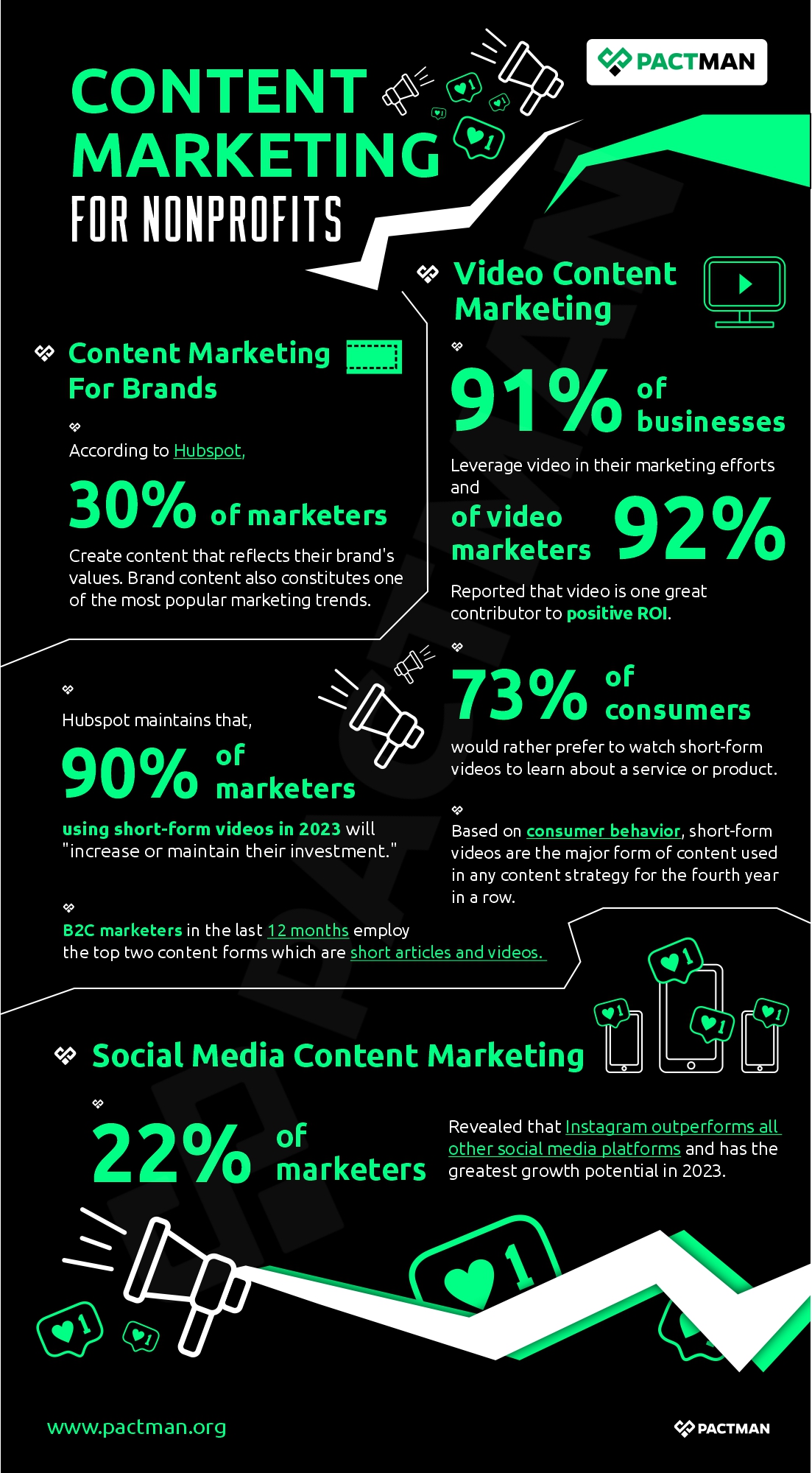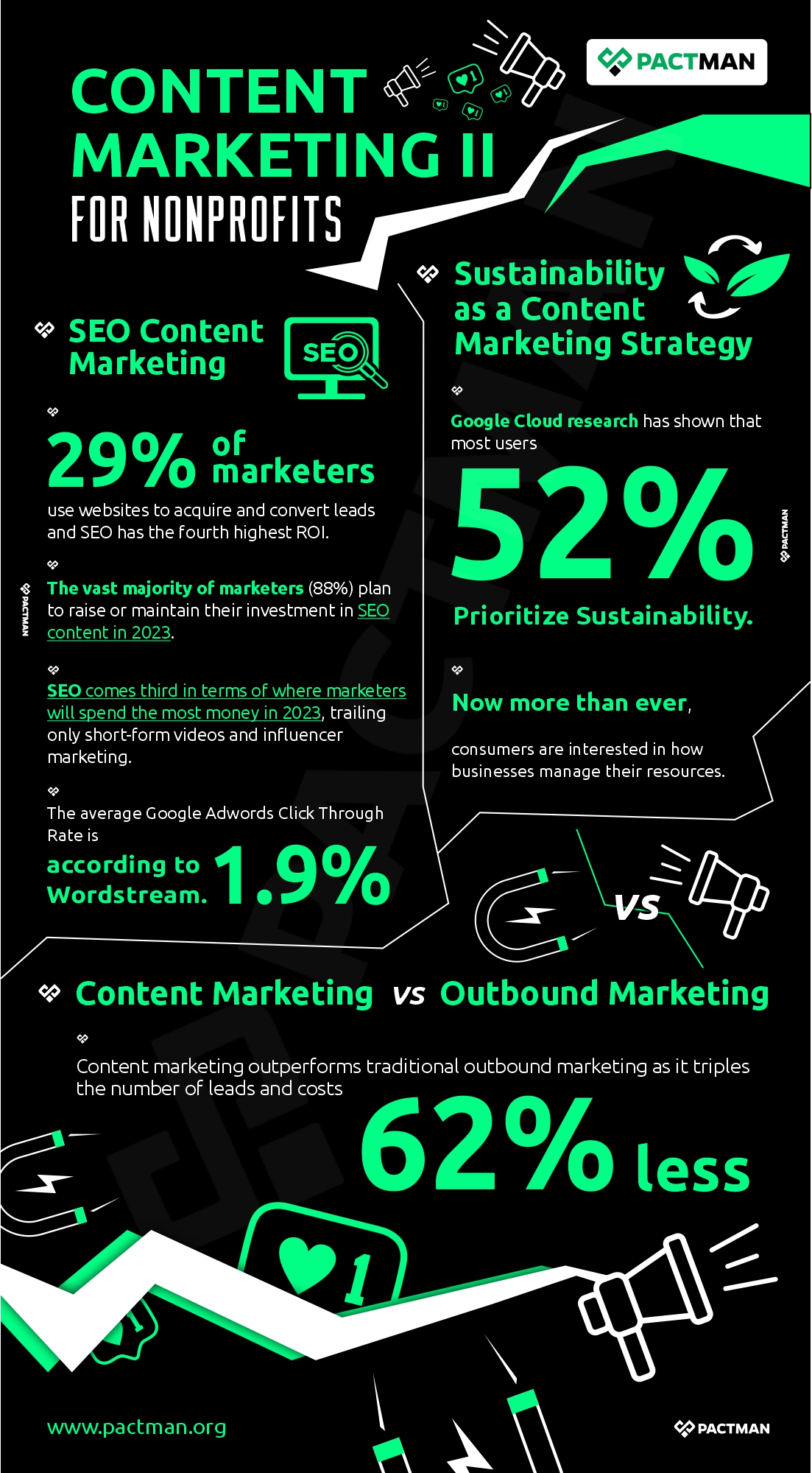I
Introduction
With a comprehensive content marketing strategy, nonprofits can reach their audience and get their message in front of the people who matter most. It is also a great way to create awareness of your organization while at the same time reaching volunteers, donors, and significant news sources.
In addition, creating content on multiple channels allows you to achieve more results. Content provided through email campaigns, social media channels, blog entries, and other means shows potential stakeholders that your organization is engaged and has authority in your niche. Likewise, your message will fall flat if you don’t have a well-rounded content creation and distribution strategy.
Now more than ever, nonprofits can benefit from improving their content marketing approach. This is because potential volunteers, partners, and funders need to have faith in your organization before they can establish interaction. Essentially, an effective content plan will aid in cultivating a sense of legitimacy.
II
What is Content Marketing?
Content Marketing entails developing and sharing online content to attract a specific audience to take action on your website. The goal could be to provide information to readers, gain clients, attract donors, or raise awareness of a campaign. In general, content marketing is about providing benefits to the clients rather than simply marketing a brand.

One of the most common ways to raise brand awareness is through knowledge sharing and storytelling. Content marketing can comprise blog articles, white papers, digital books, podcasts, videos, and so on. It is also a great way to develop a long-term relationship with your donors, which can lead to client trust and retention over time.
By and large, the goal is to make readers take action. The digital age has made content a vital component of every marketing plan. There will always be techniques that produce immediate, short-term results. However, content marketing can boost the effectiveness of your organization for a long period. Also, your digital marketing efforts can be saved by a well-executed content marketing campaign.
III
Content Marketing Statistics Worth Considering
Statistics help in providing qualitative information or context to the subject matter being presented. It also allows your organization to plan content creation based on what the audience loves and wants. More importantly, a statistical approach is a great way to avoid random guesses in your content marketing effort. An effective marketing strategy also requires the right statistics.
In this chapter, we will provide you with some marketing statistics that can aid your content strategy effort.

According to Hubspot, 30% of marketers create content that reflects their brand’s values. Brand content also constitutes one of the most popular marketing trends. We will outline some of these content formats that stand out for marketers and are also loved by the audience.
a. Videos
91% of businesses leverage video in their marketing efforts and 92% of video marketers reported that video is one great contributor to positive ROI. Hence, Hubspot maintains that 90% of marketers using short-form videos in 2023 will “increase or maintain their investment.”
Also, 73% of consumers would rather prefer to watch short-form videos to learn about a service or product. Based on consumer behavior, short-form videos are the major form of content used in any content strategy for the fourth year in a row. B2C marketers in the last 12 months employ the top two content forms which are short articles and videos.

b. SEO
We will also not fail to consider SEO which remains an important aspect of content marketing. 29% of marketers use websites to acquire and convert leads and SEO has the fourth highest ROI. Hence, the vast majority of marketers (88%) plan to raise or maintain their investment in SEO content in 2023. In addition, SEO comes third in terms of where marketers will spend the most money in 2023, trailing only short-form videos and influencer marketing.
c. Content Marketing vs. Outbound Marketing
Content marketing outperforms traditional outbound marketing as it triples the number of leads and costs 62% less. With the dominating digital age, outbound marketing is considered the traditional technique of doing business.
Outbound marketing primarily entails promotional communications that attempt to persuade consumers of the superiority of a brand, product, or service. These advertisements are shown to consumers whether they wish to view them or not. As a result, these advertisements are oftentimes forceful, interruptive, and obtrusive. With better and more improved methods to interact with brands, people no longer respond to this style of promotion.
d. Social Media
22% of marketers revealed that Instagram outperforms all other social media platforms and has the greatest growth potential in 2023.
e. Sustainability
A Google Cloud research has shown that most users (52%) prioritize sustainability. Now more than ever, consumers are interested in how businesses manage their resources. This can also apply to NGOs. Nonprofits seeking more donor retention must adopt transparency in the use of funds. More brands are using sustainability to demonstrate to their target audience that they are a socially responsible company.
To stay abreast of these trends, it’s always important to be aware of what’s going on in your sector as well as in the area of content marketing. Also, if you decide to incorporate one of these trends into your marketing strategy, make sure it is relevant to your company’s needs and will assist your organization in meeting its objectives.
IV
How to Begin Content Marketing
The realm of content marketing is vast and varied. Likewise, there is no single correct method. Content extends well beyond the written word. It includes data visualization, videos, and podcasts, among others.
Organizations with limited resources often believe that it is difficult to undertake effective content marketing. Not to mention, it is oftentimes considered a complicated process that most nonprofits hardly know where to begin.
However, you can begin your marketing journey regardless of your budget or size. All that is required is an effective strategy and the right resources.

Digital marketing entails more than just content marketing. In terms of content, every component of a digital marketing strategy necessitates some form of content. Traditional marketing, likewise, demands a content marketing approach.
Are you looking for new donors? Is your goal geared toward donor retention? Do you seek to raise awareness of your organization’s recurring campaign? It all depends on the goal you want to achieve through your content marketing efforts. This will largely inform your content strategy.
As a nonprofit, you must develop content with your intended audience in mind. Discover what motivates your target audience to act. In terms of value propositions, your content should provide value to your target audience. Some examples of value include developing content that addresses a specific need or uploading video guides.
V
What Should Be Included In Your Content Marketing Strategy?
It is rather preferable to develop a content marketing strategy before creating and distributing content across your media outlets. By and large, it allows your organization to have a unified goal with an intended outcome. However, if this is not the case, you don’t have to worry. You can begin your journey onward with a unified strategy.
In this article, we will outline what your content marketing strategy should entail.

a. A specific goal
First and foremost, your organization’s goal should be to drive client action. For most NGOs, this could be to make a donation, to attract volunteers, to solicit support, and many more. However, keep in mind that goals must be Specific, Measurable, Attainable, Realistic, and Timebound (SMART).
Break down your goals into objectives to make them more achievable. Also, define the specifics of how you want to achieve your content goals. Content marketing goals should specify who should be in charge of developing each piece of content. It’s also crucial to evaluate the tools and costs that come with content creation.
b. Audience Analysis
When you don’t know who your audiences are, it will be difficult to develop a unique brand story. Hence, the next step is to understand your target audience.
To begin, survey your current clients and readers to understand their interests. Afterward, compare your audience interests to the industry trends in your niche. Also, make sure you determine who does not fall into the target bracket.
Your content strategy should be built around audience personas.
c. Competitor Analysis
Be sure to take into account two or three competitors within your industry. An effective competitive analysis report will show your current rank compared with your competitors and areas where you can outrank your competitors. However, reports must be tailored to your industry as well as your organization’s goals. Review your competitor’s content to understand the value they provide. This will help you develop a unique strategy that addresses issues distinct from your competitors.
d. Editorial Plan and Content Calendar
An editorial plan and content calendar provides a great way to effectively allocate your resources and allocate time for each task. Content planning allows you to prioritize the needful and keep your organization on track.
Following the selection of content topics, the next step should be to determine the most significant tasks.
Firstly, consider the big picture while selecting content subjects. Likewise, your audience analysis and competitive analysis should inform your content subjects. Next, make a list of topics that are likely to be relevant in the long run.
e. A Content Creation Plan
Brainstorm ways to make content creation more efficient from the start. This allows you to focus more on developing great content. To begin with, consider some high-level strategies to optimize your content production cycle. This helps your organization to save more resources during the content strategy development stage.
Also, your organization’s expectations and KPI will determine the timeline. You can go further by estimating the number of keywords for your website content to rank. This can fall under organic traffic goals. Traffic goals can also inform your organization about the number of blog posts to publish.
Oftentimes, the early advantages of content marketing are not always obvious. It may take months or years for content marketing to reach its purpose. However, the long-term advantage that it holds for your organization cannot be underestimated.
VI
Top 6 Content Marketing Metrics to Measure
Measuring content marketing efforts allows you to know the areas you’re getting right and what needs to be improved.
There are various metrics that allow you to know if your content marketing initiatives are having enough impact to justify their expense. However, there are a few that are critical. We will consider some of the most critical content marketing metrics that every nonprofit should consider. Incorporating these metrics will provide you with a thorough insight into your organization’s performance and effectiveness.

a. Keyword Ranking
Choosing the correct keywords for your target audience is an important component of content marketing. You need to know what your target audiences are searching for on Google. After you’ve identified these critical keywords, go ahead and incorporate them into your articles.
Also, you need to know that keywords evolve over time. Hence, ensure that you are using effective words or phrases in all of your activities. Examine your keyword rankings with SEMRush or Google Search Console, and adjust your keywords or content if they aren’t doing well.
Your website’s rank can increase dramatically if you effectively optimize your site’s content. Likewise, investing in content optimization allows your site to appear organically in search engine result pages (SERPs) and generate organic interaction.
b. Traffic
It will take time to create content. However, examining content will take more time. There is a need to use statistical analytic methods to determine how effectively your articles perform. Also, understand the tools needed to measure and analyze each piece of content.
When you understand how website traffic works, you can know how your site can gain consistent traffic. First, understand your primary source of traffic. Be acquainted with the areas of your content marketing that needs improvement. When you know where your site obtains the most traffic and the type of content that garners the most views, you can make the needed changes.
Software tools such as Google Analytics allow you to view your traffic and its sources. The tool also provides the best option as it stands out for its reliable statistics on traffic sources, user behavior, and acquisitions. Google Analytics is one of the most popular platforms that content marketers use to examine their content marketing efforts.
You can also discover how many impressions your content has received by using Google Search Console. The more impressions you get, the more people you reach.
c. Customer Retention
While it’s always great to have fresh visitors, you should however strive to build relationships with readers so that you can retain as many clients as possible. Likewise, returning visitors can be used to determine what kind of content is being interacted with. This will enable you to create a marketing strategy that can offer a variety of help to readers.
Likewise, maintain regular communication with your readers. You can achieve this by asking for their comments, allowing readers to solicit future blog ideas, or inviting guest posts. Also, being socially active is one effective way to be in constant touch with your audience.
By and large, your content aids the customer’s journey. It assists your audience in making a decision and can lead to conversion. If your content can easily guide your audience through their customer journey, then it is performing well. When evaluating your content marketing performance, be sure to analyze the user experience provided by your content.
d. CTR (Click-Through-Rate)
The CTR monitoring technique may differ depending on the nature of your blog or website. However, the standard method of tracking the link between impressions and actual website clicks is to use Google Search Console’s “Search Analytics” function.
CTR is one of the key elements that Google utilizes to offer a quality score to PPC marketing campaigns. As a result, if no one is clicking on your ad, you should reconsider your ad settings, placements, and targeting. The average Google Adwords CTR is 1.9%, according to Wordstream.
Although impressions or views of your material are crucial, you won’t be able to fully comprehend whether or not your content is effective unless you acknowledge your CTR or click-through rate. With more people viewing or consuming your material, how does it influence their choice to take action? Is your content acquainting them with your service and projects? Understanding your click-through rate gives you all the necessary information.
e. Backlinks & Shares
Backlinks are as important today as they were in the past. Even though the technique of obtaining and validating backlinks has been revised, powerful backlinks will still serve your organization well in terms of SEO. As a result, you should investigate which sites are connecting to you and how you can ensure that your work is worthy of citation in the future.
The actual litmus test for your material is if people find it useful or fascinating enough to share it with their audiences. Plus, the more people share your articles, the more Google perceives them as the “solution” and exposes them to more readers. Shares are simple to calculate when publishing on social media. However, if you want to view the shares of your blog articles, you can use tools like BuzzSumo or Ahrefs.
f. Email Opt-In Rates
Although e-mail subscriptions may not be considered a top priority for some organizations, they are nevertheless a vital metric that should be measured. Those who have subscribed to your newsletter or email list have clearly found value in your content and yearned for more of the same. Such content can serve as a model for future posts.
Email marketing software providers such as MailChimp and Constant Contacts can take your email marketing and tracking efforts to the next level.
When your content marketing is effective, readers will be willing to share their contact information with you and eager to hear more of what you have to say. This is one great way to attract the audience’s participation in donations or volunteer activities in the future.
It may appear difficult to keep up with the ever-changing trends, especially in the area of content marketing. Nevertheless, it is critical to keep your organization at the forefront of your industry. Always stay abreast of key statistics in content marketing and be up to date with trends.
A genuinely successful content marketing strategy will use compelling content to attract potential donors and readers. On the other hand, you can increase engagement with prior clients or future clients who are still indecisive.
Conclusion
A clearly outlined goal as well as a good storytelling technique helps in creating content that matters to your audience. Whether it’s informational, inspirational, or a guide, be sure to communicate it in the best way possible. The finest way to market your content is by putting yourself in your audience’s shoes and trying to understand their needs. Also, do not separate content marketing from your other marketing endeavors.

Remember, content marketing comprises all creative efforts spread across numerous channels such as a blog, newsletters, YouTube, and social media platforms. Hence, define your target audience clearly. Also, keep in mind that the purpose of all content is to effectively motivate stakeholder behaviors. You can also have secondary goals in addition to your core goal. However, nonprofit content marketing should be focused on the activities you want the user to perform.



3 Responses